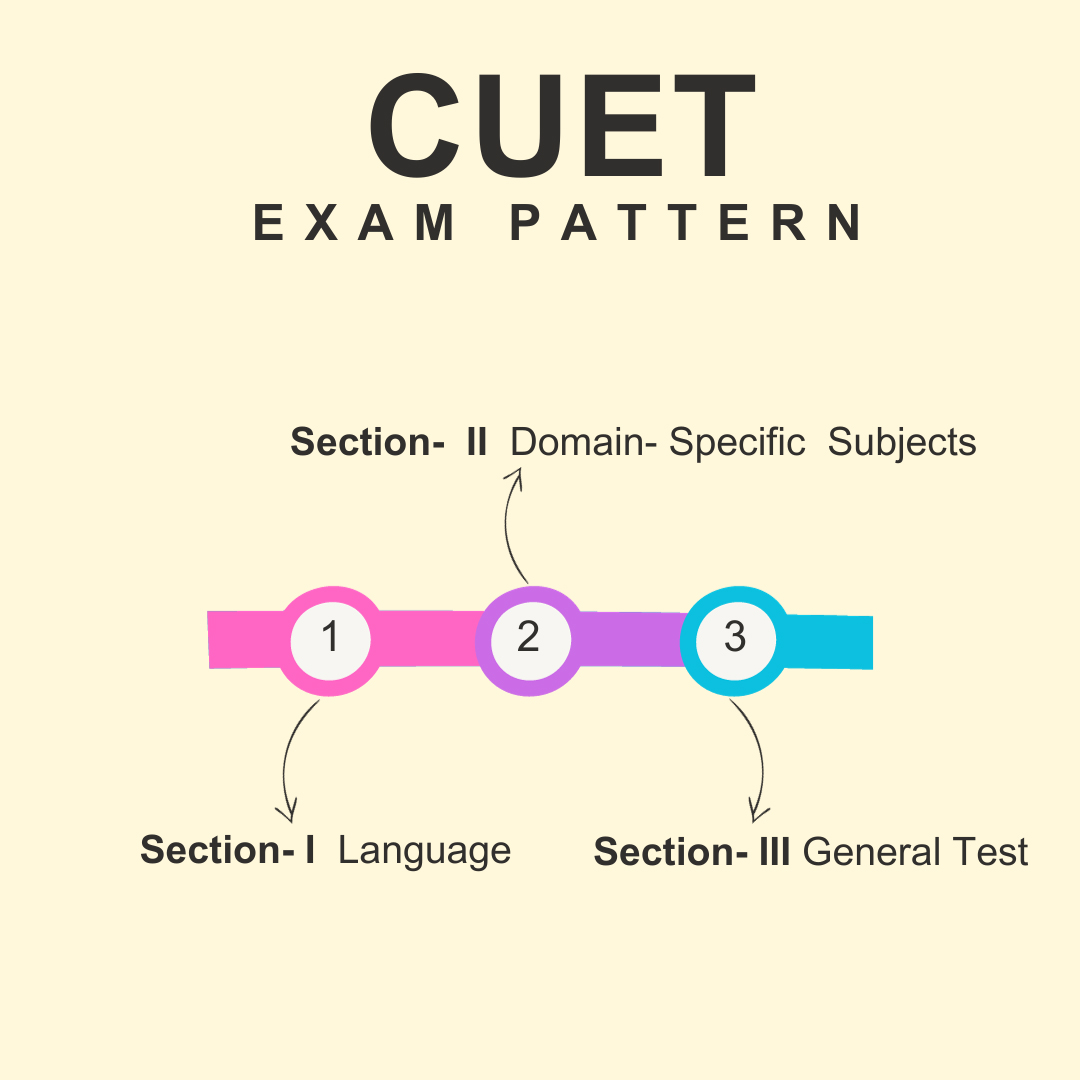
|
Sections/Subjects
|
Total Questions
|
Questions to be attempted
|
|
Section I– Language
|
50
|
50
|
|
Section II– Domain Subjects
|
50
|
50
|
|
Section III– General Test
|
60
|
60
|
|
Section
|
Subjects
|
Questions to be Attempted
|
Duration
|
|
Section I
|
There are 13 different languages
|
50 Questions to be attempted
|
60 minutes for each language
|
|
Section II - Domain
|
Students can choose around 2-3 subjects from 23 Domains offered.
|
50 Questions to be attempted
|
60 Minutes
|
|
Section III - General Aptitude Test
|
For undergraduate programs using a General Test for university admission.
|
60 Questions to be attempted
|
60 Minutes
|
|
Subjects
|
Topics to be covered (Unit wise)
|
|
Anthropology
|
Unit I: Physical Anthropology
Unit II: Prehistoric Archaeology
Unit III: Material culture & economic Anthropology
Unit IV:Social Anthropology & Ethnography
Unit V: Ecology
|
|
Environmental Studies
|
Unit I: Human Beings and Nature
Unit II: Population and Conservation Ecology
Unit III: Monitoring Pollution
Unit IV: Third World Development
Unit V: Sustainable Agriculture
Unit VI: Environmental and Natural Resources Economics
Unit VII: International Relations and Environment
|
|
Computer Science / Informatics Practices
|
Unit I: Exception and File Handling in Pythonan
Unit II: Stack
Unit III: Queue
Unit IV: Searching
Unit V: Sorting
Unit VI: Computer Networks
Unit VII: Data Communication
Unit VIII: Database query using SQL
|
|
Economics/Business Economics
|
Unit I: Introduction to Microeconomics
Unit II: Consumer Behaviour and Demand
Unit III: National Income and Related Aggregates
Unit IV: Determination of Income and Employment
Unit V: Money and Banking
Unit VI: Government Budget and the Economy
Unit VII: Balance of Payments
Unit VIII: Development Experience and Economic Reforms since 1991
Unit IX: Current Challenges Facing the Indian Economy
Unit X: Development Experience in India
|
|
Fine Arts / Visual Arts/(Sculpture/Painting)/ Commercial Art
|
Unit I: The Rajasthani and Pahari Schools of Miniature Painting
Unit II: The Mughal and Deccan schools of miniature painting
Unit III: The Bengal School and Cultural Nationalism
Unit IV: The Modern Trends in Indian Art
|
|
Geography/ Geology
|
Unit I: Human Geography: Nature and Scope
Unit II: People
Unit III: Human Activities
Unit IV: Transport, Communication and Trade
Unit V: Human Settlements
Unit VI: Geographical Perspective on Selected Issues and Problems
|
|
History
|
Unit I: The Story of the First Cities Harappan Archaeology
Unit II: Political and Economic History: How Inscriptions tell a story
Unit III: Social Histories using the Mahabharata
Unit IV: A History of Buddhism: Sanchi Stupa
Unit V: Medieval Society ThroughTravellers’ Accounts
Unit VI: Religious Histories: Bhakti Sufi Tradition
Unit VII: New Architecture: Hampi
Unit VIII: Agrarian Relations :The Ain-i-Akbari
Unit IX: The Mughal Court: Reconstructing Histories
through Chronicles
Unit X: Colonialism and Rural Society: Evidence from Official Reports
Unit XI: Representations of 1857
Unit XII: Colonialism and Indian Towns: Town Plans and Municipal Reports
Unit XIII: Mahatma Gandhi through Contemporary Eyes
Unit XIV: Partition through Oral Sources
Unit XV: The Making of the Constitution
|
|
Home Science
|
Unit I: Nutrition, Food Science and Technology
Unit II: Human Development: Lifespan Approach
Unit III: Fabric and Apparel
Unit IV: Resource Management
Unit V: Communication and Extension
Unit VI: Career options after Home Science Education
|
|
Knowledge Tradition Practices India
|
Unit I: Agriculture: A Survey
Unit II: Architecture: A Survey
Unit III: Dance: A Survey
Unit IV: Education Systems and Practices: A Survey
Unit V: Ethics: Individual and Social
Unit VI: Martial Arts Tradition: A Survey
Unit VII: Language and Grammar
Unit VIII: Other Technologies: A Survey
|
|
Media/Mass Communication
|
Unit I: Communication
Unit II: Journalism
Unit III: TV
Unit IV: Radio
Unit V: Cinema
Unit VI: Social Media
Unit VII: New Media
|
|
Performing Arts
|
Section A: Hindustani Karnatak Music
Section B: Dance
Section C: Percussion Music- Hindustani Karnataka
Section D: Drama-Theatre
|
|
Physical Education/National Cadet Corps (NCC)/ Yoga
|
Unit I: Sociological Aspects of Physical Education
Unit II: Training Methods
Unit III: Career Aspects in Physical Education
Unit IV: Career Aspects in Physical Education
Unit V: Health Education & Health Problems
Unit VI: Sports Injuries and First Aid
Unit VII: Test and Measurement in Sports
Unit VIII: Biomechanics and Sports
Unit IX: Psychology & Sports
|
|
Political Science
|
Unit I: Political Theory
Unit II: Indian Government and Politics
Unit III: Comparative Politics
Unit IV: International Relations
Unit V: Public Administration
Unit VI: Political Ideologies
|
|
Psychology
|
Unit I: Foundations of Psychology
Unit II: Developmental Psychology
Unit III: Social Psychology
Unit IV: Psychological Disorders
Unit V: Therapeutic Approaches
Unit VI: Applied Psychology
|
|
Sociology
|
Unit I: Introducing Sociology
Unit II: Understanding Society
Unit III: Social Institutions: Continuity and Change
Unit IV: Patterns of Social Inequality and Exclusion
Unit V: The Challenges of Cultural Diversity
Unit VI: Indian Sociologists
|
|
Teaching Aptitude
|
Unit I: Teaching-Learning Process
Unit II: Learner & Characteristics
Unit III: Methods of Teaching
Unit IV: Evaluation and Assessment
Unit V: Classroom Management
Unit VI: Educational Technology
|